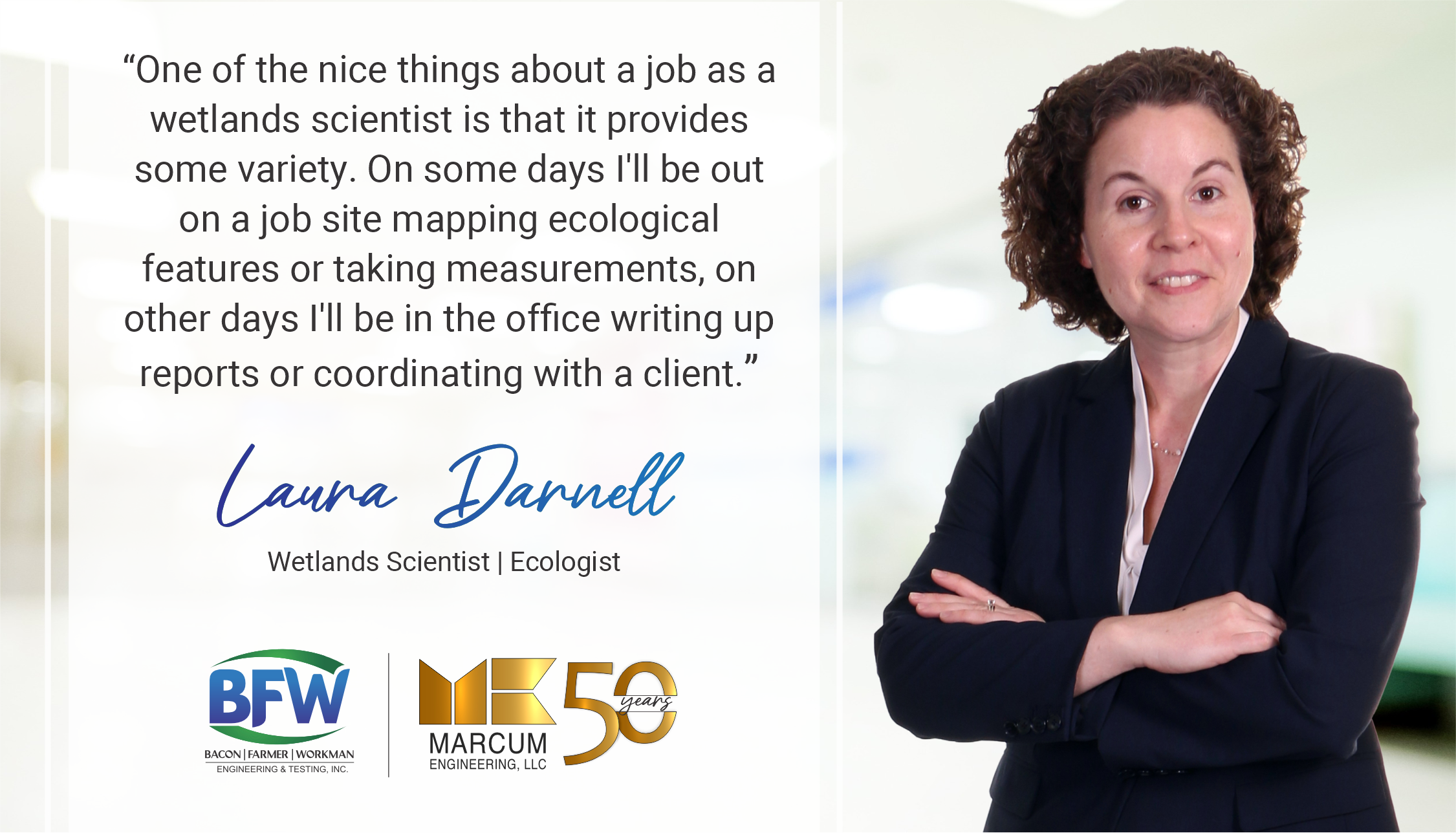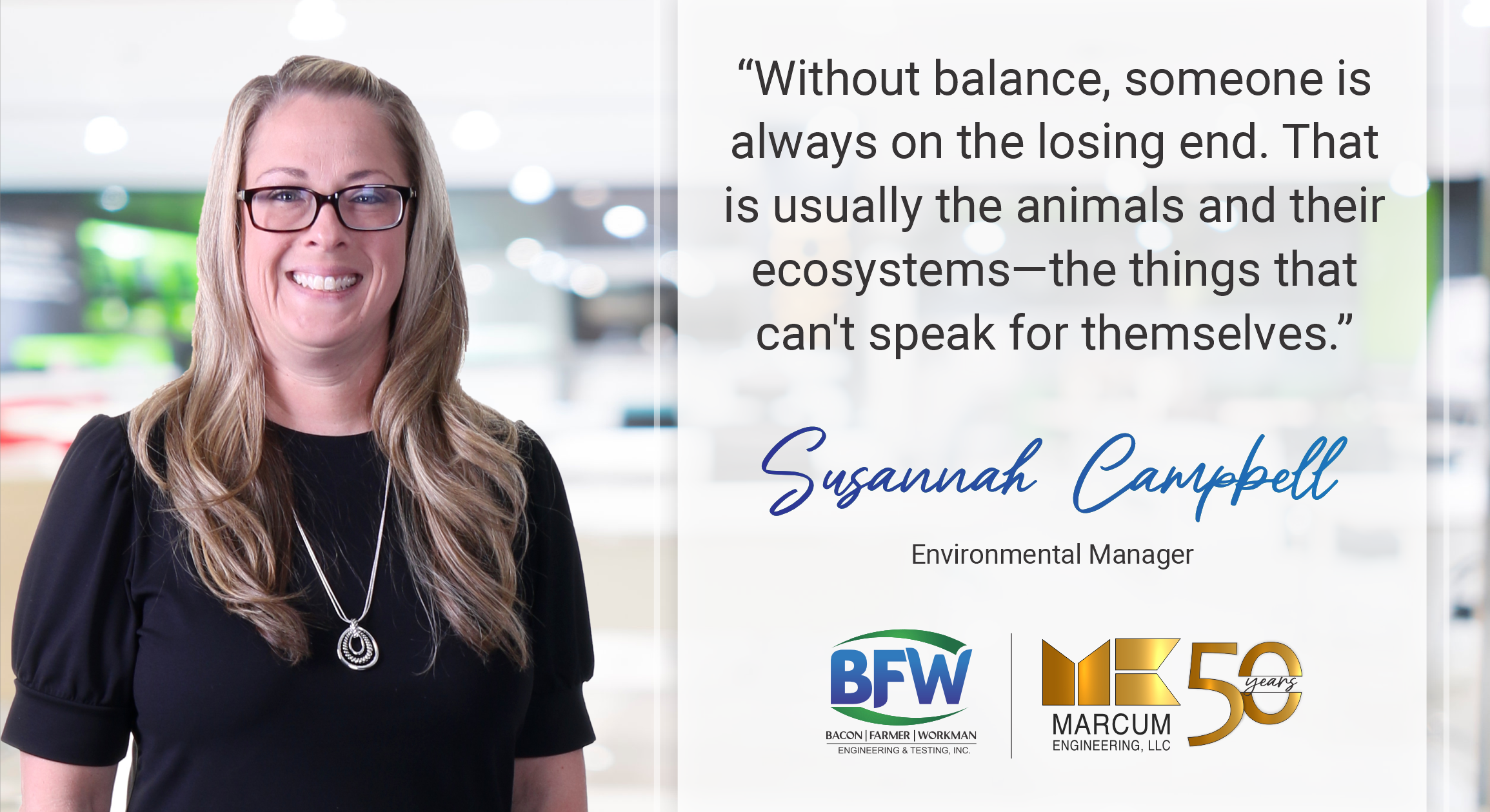You can’t just build wherever you want, even if the area looks empty. A barren expanse of land might look innocuous to the untrained eye, but these areas specifically are ones in which wildlife teems. After all, as we expand our cities and suburbs, we change the existent, age-old habitats of local animals and may even displace them. That riverbed, waterway, or even the seasonal pond (we call them vernal pools) is an essential part of the lifecycle of many animals, big, small, and even microscopic.
Even the culverts and other manmade structures are, through necessity, essential pieces of the ecosystem for these animals. They’ve learned to cope, and, through our thoughtful building, can live in a new kind of harmony with us. We sat down with Susannah Campbell, Environmental Manager, and Laura Darnell, Wetlands Scientist/Ecologist to discuss these systems and our efforts to preserve or complement them.
The Clean Water Act & USACE 404 Compliance
Susannah is no stranger to the Clean Water Act, “The Clean Water Act is a federal law passed in 1972 in the United States. Its primary goal is to protect and restore the quality of the nation’s water resources. The act regulates the discharge of pollutants into the waters of the United States, including rivers, lakes, streams, and coastal areas.
It sets standards for water quality and establishes the framework for issuing permits to control pollution from various sources such as industrial facilities and wastewater treatment plants. The Clean Water Act also provides funding for wastewater treatment infrastructure and supports programs to monitor and assess the health of water bodies. Overall, it aims to ensure that the nation’s waters are safe for drinking, swimming, fishing, and other beneficial uses.”
It’s hard to believe that, until 1972, building and construction were a relative “no man’s land” when it came to its impact on ecosystems. Construction practices often had fewer regulations regarding the protection of ecosystems and water bodies. Construction activities, such as the building of roads, bridges, and developments, could result in significant environmental impacts, including the destruction of ecosystems.
Erosion is a serious threat to water systems. Susannah explains the need to comply with USACE 404 regulations. “USACE 404 compliance requires obtaining a permit from the U.S. Army Corps of Engineers for activities that involve discharging dredged or fill material into water bodies. The process involves applying for the permit, outlining project plans, potential impacts, and proposed mitigation measures. It ensures that projects are conducted responsibly, protecting wetlands, water quality, and the habitat of plant and animal species.”
We Advocate for Ecosystems
Entering stage left is Laura. As a wetlands scientist, she’s the greatest advocate for the delicate ecosystems that can be disastrously impacted by poorly-planned engineering and construction.

“One of the nice things about a job as a wetlands scientist is that it provides some variety. On some days I’ll be out on a job site mapping ecological features or taking measurements, on other days I’ll be in the office writing up reports or coordinating with a client.
However, the different day-to-day tasks are steps in the same process which is about keeping projects in compliance with the Clean Water Act. We document what stream and wetland resources are in the project area and then determine how the project could impact them and what laws and rules apply to them. Then, if government permits are needed for stream or wetland impacts, we develop reports to apply for those authorizations and follow up with the government agencies as needed.”
Wetlands are a Noble Challenge
While it’s not typical to build over wetlands (unless you’re someone like Walt Disney,) it’s very common to find wetlands adjacent to a construction project that need to be accounted for. Laura explains.
“Working around wetlands has its challenges, but a lot of the precautions are like other sensitive environmental features such as streams, ponds, sinkholes, or tree preservation areas. Many wetlands are in areas where you wouldn’t want to build for other reasons, such as being in a regulated floodplain or beside a stream that occasionally floods outside of its banks.
On active construction sites, protection measures such as exclusion fencing, and silt fencing can be installed to avoid or minimize impacts to wetlands in the area. One potential conflict that could develop is if you are required to install water quality protection measures like sediment basins or check dams, and the low-lying areas where you would usually want to install contain wetlands. That scenario might require some extra effort to alter the site layout or get authorizations for wetland impacts.”
Laura is one of the key people that doesn’t just look at the site at hand. She looks at the larger region and determines the impact, with the help of federal regulation, of the wider ecosystem.
Pre-70s Industry Has Impacted Wetlands, We’re Here to Preserve the Rest
“It’s estimated that around half of the wetlands that were originally present in the United States before European settlement have been drained. Today, major areas of wetland in the BFW/Marcum service area tend to be concentrated around large river systems such as the Mississippi River and lower Ohio River, and major tributaries to those rivers. However, smaller wetlands are not uncommon and show up frequently in many kinds of landscapes”, explains Laura.
The current state of these ecosystems runs concurrently with many of the other endangered ecosystems in the country; there is a lot less of it, so it’s important to protect what remains, but we tend to underestimate how much-untouched land there is in this country. It’s a bit of a paradox. We must preserve what little we have while admiring how much there was, to begin with. Our region has, on average, 1.5-5% of its land acreage as wetlands. That’s low, but more than you’d think!
Let’s Talk Gravel
Rock, gravel, aggregate—call it what you want. Unless you’re in the world of engineering and construction, you might not understand the nuance of the term, nor the vast importance of the material. Susannah chimes in, “USACE 404 compliance could be considered a direct response to the need for aggregate. As we mine sources, we risk damaging ecosystems through pollution, erosion, and displacement of animals.”
Laura explains the importance and impact of our need for gravel. “Gravel is an important construction material because it’s a type of aggregate, loosely defined as small pieces of rock or sand. Aggregate material can be obtained by mining natural deposits in areas of old glacial deposition or former riverbeds, or by extracting the gravel material from streams or rivers.
Aggregate can also be produced by crushing larger rocks, which produces a slightly different product because its surfaces are more angular than natural particles which were smoothed by their time in the river. Construction applications generally require sorted aggregate of a specific size and material. Aggregate is a key component in many construction applications that are essential to our daily lives including concrete, asphalt, roadbeds, railroad beds, and construction fill material.”
To put it simply, we need the kind of gravel collected from the bottoms of water sources, but we need to mine this material sustainably and without harming the regional ecosystems that can be easily thrown out of whack by the process of gathering it.
We Want Everyone to Win
“Without balance,” Susannah explains, “someone is always on the losing end. That is usually the animals and their ecosystems—the things that can’t speak for themselves.”

Laura agrees. “Balancing new construction with existing natural ecosystems can create a win-win situation. Natural areas provide ecosystem services that provide benefits for people, and these can include water quality improvements, erosion protection, flood reduction, air cooling, and wildlife habitat. Incorporating natural habitats into a project can enhance its aesthetics and its sense of place and increase access to nature which can give people an emotional lift.”
Laura hits on something very interesting in her closing marks—a tenet that BFW/Marcum lives by. That is a sense of place. We want our work to be inclusive of everyone and everything. Everything needs its place, especially when it was there before us.

Recent Comments